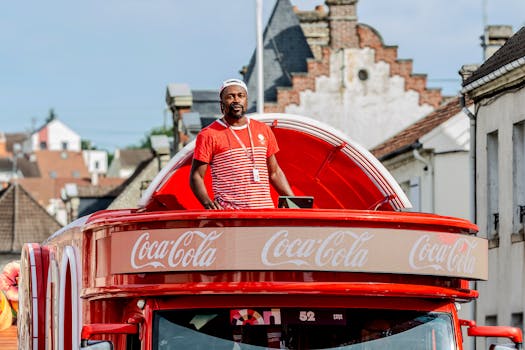Anúncios
O conteúdo desempenha um papel vital na indústria de atividades ao ar livre, influenciando como as experiências são compartilhadas, percebidas e engajadas. À medida que os entusiastas de atividades ao ar livre buscam se conectar com a natureza, o conteúdo certo pode inspirá-los a explorar mais. Além disso, as empresas desse setor utilizam estratégias de conteúdo eficazes para alcançar um público mais amplo e transmitir a história de suas marcas.
Nos últimos anos, a proliferação de plataformas digitais revolucionou o compartilhamento de conteúdo. De blogs a mídias sociais, diversos formatos permitem um engajamento mais profundo com atividades ao ar livre. Esse engajamento não apenas cultiva um senso de comunidade, mas também fornece informações valiosas que aprimoram as experiências ao ar livre.
À medida que a indústria de atividades ao ar livre continua a evoluir, o papel do conteúdo torna-se cada vez mais fundamental. Conteúdo forte e envolvente é essencial para que marcas e organizações permaneçam relevantes e influentes em um cenário competitivo. Compreender sua importância pode ajudar empresas e indivíduos a aproveitar o poder da narrativa.
Compreendendo os tipos de conteúdo na indústria de atividades ao ar livre
A indústria de atividades ao ar livre abrange uma variedade de tipos de conteúdo, cada um adaptado a diferentes públicos. Isso inclui artigos, vídeos, infográficos e postagens em mídias sociais, todos com o objetivo de aprimorar a experiência ao ar livre. Essa diversidade permite a expressão criativa, ao mesmo tempo em que educa e inspira aventureiros.
Os artigos geralmente fornecem informações detalhadas sobre destinos, técnicas e equipamentos. Eles também podem compartilhar histórias pessoais que ressoam com os leitores, promovendo uma conexão mais profunda. Artigos bem elaborados têm o potencial de obter uma classificação mais alta nos mecanismos de busca, atraindo mais tráfego para os sites.
Anúncios
Os vídeos servem como um meio dinâmico de contar histórias, apresentando experiências em tempo real. Eles permitem que os espectadores explorem visualmente trilhas, cursos d'água e locais de acampamento. Conteúdo em vídeo envolvente pode aumentar significativamente os compartilhamentos sociais e a retenção de público.
Infográficos apresentam informações complexas em formatos de fácil assimilação. Eles tendem a chamar a atenção e podem transmitir dados essenciais sobre atividades ao ar livre, como dicas de segurança ou proteção ambiental. Esses recursos compartilháveis aumentam o engajamento do usuário.
Postagens em redes sociais, incluindo imagens e vídeos curtos, promovem o engajamento da comunidade. Elas oferecem uma plataforma para os usuários compartilharem suas experiências, inspirando outros a aderirem ao movimento ao ar livre. Esse tipo de conteúdo geralmente incentiva a interação por meio de comentários e compartilhamentos.
Anúncios
O Impacto do Conteúdo Gerado pelo Usuário (CGU)
O conteúdo gerado pelo usuário (CGU) surgiu como um aspecto fundamental do cenário de conteúdo outdoor. As marcas incentivam seus clientes a compartilhar fotos, vídeos e avaliações, promovendo autenticidade e envolvimento da comunidade. O CGU constrói fidelidade à marca e confiança entre os consumidores.
Quando clientes em potencial veem usuários reais aproveitando produtos ou experiências, isso valida suas decisões de compra. Eles são mais propensos a confiar em avaliações positivas de outros entusiastas do que em publicidade tradicional. Esse tipo de conteúdo é altamente eficaz para atrair alcance orgânico.
Além disso, o UGC incentiva o engajamento nas plataformas de mídia social. Marcas que promovem ativamente as contribuições dos usuários cultivam um senso de pertencimento entre seus seguidores. Ao exibir o conteúdo do usuário, as empresas podem criar um ambiente mais inclusivo.
Notavelmente, o UGC pode ser reaproveitado para campanhas de marketing. As empresas podem apresentar histórias e imagens de clientes em suas plataformas, aumentando a visibilidade da marca. Isso não apenas fortalece a identidade da marca, mas também enfatiza aplicações reais de produtos ou serviços.
Ao adotar o CGU, as empresas também motivam suas comunidades a explorar atividades ao ar livre. Isso não apenas promove seus produtos, mas também fomenta o amor pela vida ao ar livre, inspirando uma maior apreciação pela natureza.
Estratégias de SEO para conteúdo externo
Desenvolver estratégias eficazes de otimização para mecanismos de busca (SEO) é fundamental para aumentar a visibilidade do conteúdo outdoor. Conteúdo devidamente otimizado garante que apareça em resultados de busca relevantes, atraindo o público desejado. A implementação de SEO envolve diversas técnicas e práticas recomendadas.
A pesquisa de palavras-chave é a base de qualquer estratégia de SEO. Identificar palavras-chave relevantes que potenciais clientes buscam pode influenciar a criação de conteúdo. É essencial integrar essas palavras-chave naturalmente em títulos, cabeçalhos e corpo de texto.
Criar conteúdo valioso e de alta qualidade que responda às perguntas dos leitores aumenta o engajamento. Incorporar elementos multimídia, como imagens e vídeos, também pode aprimorar a experiência geral do usuário. Usuários engajados têm maior probabilidade de permanecer na página por mais tempo, reduzindo as taxas de rejeição.
Além disso, otimizar meta descrições e tags ajuda a melhorar o posicionamento nos resultados de busca. Elas fornecem resumos concisos e atraentes que incentivam cliques. Usar ferramentas para analisar o desempenho do site pode facilitar melhorias contínuas na estratégia de conteúdo.
A construção de links é outro elemento crucial em SEO. Construir backlinks de fontes confiáveis ajuda a estabelecer credibilidade e autoridade. Quando sites confiáveis criam links para o seu conteúdo, isso pode aumentar a visibilidade e atrair mais visitantes.
O papel da comunidade no conteúdo ao ar livre
O envolvimento da comunidade molda significativamente o conteúdo sobre atividades ao ar livre, promovendo conexões entre entusiastas. Comunidades locais frequentemente organizam eventos, workshops e atividades de limpeza, gerando oportunidades de conteúdo que destacam seu compromisso com atividades ao ar livre. Esses eventos não apenas fortalecem os laços sociais, mas também criam experiências compartilhadas que repercutem no público.
Aumentar o engajamento da comunidade por meio de narrativas é vital. Empresas e influenciadores locais podem apresentar jornadas pessoais, expondo a rica coleção de experiências vividas em seus bairros. Essas narrativas inspiram outras pessoas a explorar e apreciar os recursos locais ao ar livre.
A colaboração entre diversas entidades comunitárias é igualmente importante. Parcerias entre organizações, influenciadores e marcas podem amplificar mensagens e criar conteúdo abrangente. Campanhas conjuntas podem abordar questões importantes, como preservação ambiental ou acessibilidade.
Promover um ambiente inclusivo é fundamental para construir uma comunidade próspera ao ar livre. Destacar vozes e experiências diversas promove a exploração e incentiva a participação de novatos. A representação em conteúdo sobre atividades ao ar livre ajuda a fomentar um senso de pertencimento.
De modo geral, criar conteúdo centrado em experiências e valores comunitários pode gerar interesse e participação em atividades ao ar livre. Transforma aventuras ao ar livre em jornadas compartilhadas que enriquecem todos os envolvidos.
Medindo o sucesso do conteúdo ao ar livre
Medir a eficácia do conteúdo outdoor é essencial para a melhoria contínua. A utilização de diversas ferramentas de análise fornece insights sobre o comportamento do público, métricas de engajamento e alcance geral. Identificar esses padrões ajuda a refinar as estratégias de conteúdo para obter melhores resultados.
Métricas comuns para monitorar incluem visitas a páginas da web, tempo gasto nas páginas e interações em mídias sociais. O aumento do engajamento indica um conteúdo de sucesso que repercute no público. A avaliação dessas métricas fornece insights práticos para a criação de conteúdo futuro.
As taxas de conversão são outro indicador crucial do sucesso do conteúdo. Monitorar quantos leitores se tornam clientes pode informar a eficácia das campanhas de marketing. Conteúdo que impulsiona vendas pode precisar ser priorizado em projetos futuros.
Coletar feedback do público, por meio de pesquisas ou comentários, oferece dados qualitativos valiosos. Entender o que repercute no seu público pode orientar a direção e os tópicos do conteúdo. O engajamento direto com os consumidores permite estratégias de conteúdo mais personalizadas.
Revisar e adaptar regularmente o conteúdo com base nas análises coletadas garante relevância no setor de atividades ao ar livre em constante evolução. A análise contínua resulta em conteúdo mais eficaz, que engaja o público e cultiva a paixão pela vida ao ar livre.
Tendências futuras em conteúdo ao ar livre
O futuro do conteúdo para atividades ao ar livre está preparado para desenvolvimentos empolgantes à medida que a tecnologia continua a evoluir. Tendências emergentes como realidade virtual (RV) e realidade aumentada (RA) podem remodelar a forma como as experiências são compartilhadas. Essas tecnologias podem proporcionar experiências imersivas, permitindo que os usuários explorem o ar livre de suas casas.
À medida que a sustentabilidade se torna um ponto focal, o conteúdo focado em práticas sustentáveis provavelmente ganhará destaque. Mais consumidores buscam atividades e produtos ao ar livre ecologicamente responsáveis, o que influencia a direção do conteúdo e a mensagem da marca.
Além disso, os avanços em conteúdo otimizado para dispositivos móveis são cruciais. Como os entusiastas de atividades ao ar livre frequentemente dependem de seus smartphones para planejar viagens e navegar, otimizar o conteúdo para acesso móvel é essencial. Criar designs responsivos garante experiências mais fáceis para o usuário em qualquer lugar.
A narrativa visual continuará sendo essencial para capturar a atenção. Visuais de alta qualidade podem inspirar e motivar o público a se envolver com atividades ao ar livre. As marcas provavelmente investirão mais em conteúdo fotográfico e em vídeo impressionante para destacar a aventura.
Por fim, a inclusão e a acessibilidade nas estratégias de conteúdo serão essenciais para ampliar a comunidade de atividades ao ar livre. Garantir uma representação diversificada em narrativas sobre atividades ao ar livre promove uma maior apreciação pela natureza entre diferentes grupos demográficos e incentiva mais pessoas a explorar.
Conclusão
Em resumo, o conteúdo desempenha um papel essencial na construção de experiências na indústria de atividades ao ar livre. Ele inspira as pessoas a se envolverem com a natureza, as educa sobre as melhores práticas e promove a comunidade. À medida que a tecnologia evolui e os públicos mudam, a eficácia das estratégias de conteúdo continuará a melhorar.
Seja por meio de conteúdo gerado pelo usuário, otimização de SEO ou envolvimento da comunidade, empresas e organizações podem aprimorar sua presença no espaço ao ar livre. A adaptação contínua às tendências emergentes garante relevância e incentiva o amor pela natureza.
Em última análise, o futuro do conteúdo ao ar livre é promissor, com infinitas possibilidades de criatividade e colaboração. Adotar diversos tipos e estratégias de conteúdo aprimorará a experiência ao ar livre para todos os entusiastas.



